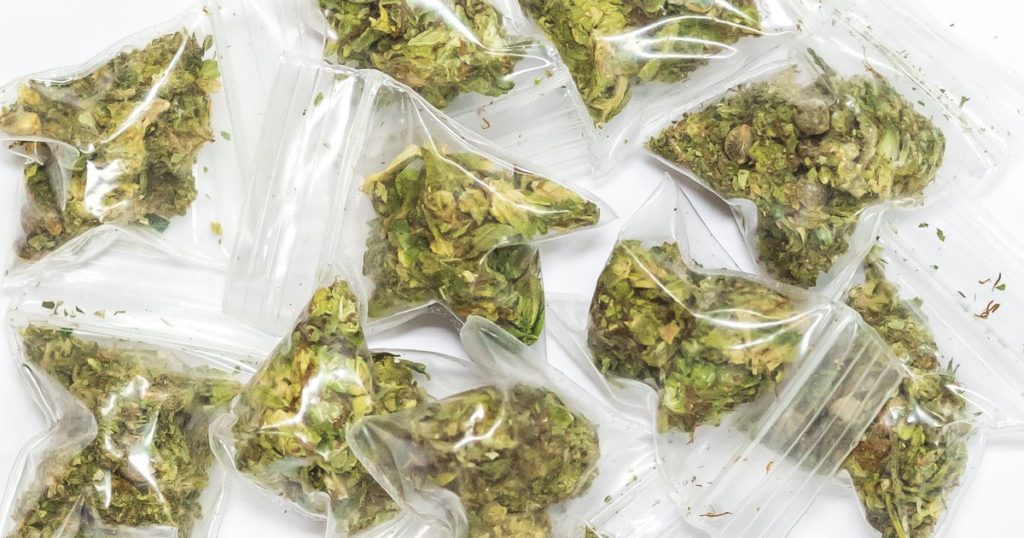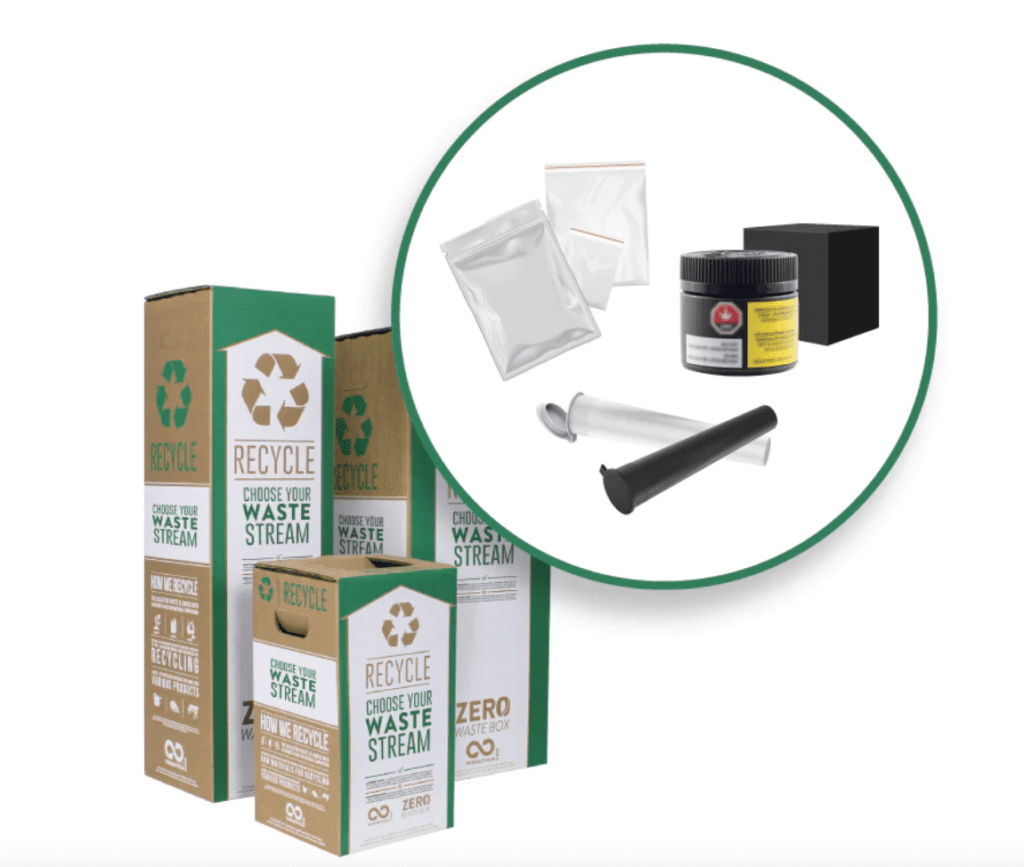Weeding Out Plastic Waste in the Cannabis Industry
The cannabis industry has been a hot topic since the legalization of marijuana in Canada in 2018, but there’s one facet of the industry that isn’t often discussed– the plastic waste. The reality is that cannabis is a growing industry with strict packaging guidelines and requires the same attention as other packaging sectors when it comes to plastic waste. It’s estimated that in the first years of legalization in Canada, 5.8 to 6.4 million kilograms (approximately 12.7 to 14.1 million pounds) of plastic cannabis packages ended up in landfills. That’s just one year’s worth of plastic packaging waste in a brand new industry. It’s worrying to think how much this amount could have grown in the last four years.

Credits to https://www.bbc.com/
Statistics Canada reports that more than 100 million units of dried flower medical and non-medical cannabis were sold across the country in 2021. Dried cannabis is one of the biggest culprits of overpackaging, as a small amount of cannabis is often packed in an oversized, unrecyclable jar. While the statistics related to the sales of dried cannabis in kilograms are not yet updated for 2021, research shows that for every standard 3.5 grams package of dried cannabis sold, approximately 70 grams of plastic packaging is used. That’s twenty times the product weight in plastic packaging.
Consumers of cannabis products are not happy with the excessive use of plastic in cannabis packaging, particularly unrecyclable plastics. In a survey of cannabis users performed by a researcher at Ryerson University, it was determined that packaging is one of the two main concerns from consumers about the industry, the other being price. Approximately 73% of respondents in the survey rated the issue of plastic cannabis packaging highly (choosing 4 or 5 out of 5 on a scale of importance). Consumers are tired of seeing all the waste that comes along with their cannabis purchase, and want to see change in the industry.
The most popular cannabis packaging used by producers since the legalization of marijuana has been black plastic. Whether it’s solid black plastic jars or black plastic, mixed material mylar bags, these black plastics are not widely recyclable. Cannabis manufacturers often use a double-walled polypropylene jar or a polyethylene terephthalate (PET) as packaging for their products. These packaging options offer dry conditions for the product and prevent contamination due to the plastic’s vapour and moisture barriers. Some cannabis companies will also defend their choice of plastic packaging, particularly plastic bags, by submitting that they’re the lightest, least material intensive packaging available, which also has the benefit of improving their carbon footprint. But we know that lightweighting plastic packaging is not necessarily the solution to plastic waste that many want it to be.
In the Ryerson survey of cannabis consumers, 47% of respondents reported that they assume most plastic cannabis packaging is recyclable, so they recycle their empty cannabis packaging. Most, if not all, plastic cannabis packaging is actually not recyclable in Canada, especially not in curbside programs. Consumers will often buy non-recyclable packaging, thinking that it must be recyclable because it’s plastic, and throw it into their recycling bin hoping for the best. These wish cycled plastics do not get recycled and instead end up in landfills, despite the consumer’s best intentions to properly dispose of the waste.


Credits to https://www.phillyvoice.com/
One of the major barriers to changing cannabis packaging, and incorporating more sustainable materials, is the existing framework of packaging regulations. Health Canada has established very specific requirements for cannabis packaging. To meet Health Canada’s packaging and labelling criteria, cannabis packages must be opaque or translucent in colour, have child-resistant mechanisms, include a security seal, and be large enough to accommodate all of the required information in both French and English in a minimum font size. A study from McGill has put forward that the strict packaging requirements are leading producers to use larger and more resource-intensive containers than necessary. The regulations also prohibit companies who are packaging more sustainably from promoting their initiatives, which makes it more difficult for consumers to understand the non-plastic alternatives available on the market.
The regulations have proven to be a factor limiting the ability to implement widespread packaging changes, but they have also discouraged innovation. Many producers are reluctant to take the chance and try something new with their packaging for fear of being reprimanded by Health Canada or unintentionally violating a packaging rule. Health Canada has suggested that it encourages sustainable and innovative packaging solutions, but the regulations do not provide specific guidance on how those solutions fit into the existing regulations. Although Health Canada is an agency tasked with prioritizing the health of Canadians and isn’t directly responsible for environmental impacts, we would suggest that plastics are a health concern for Canadians, and that plastic packaging should be a topic of conversation in drafting any package labelling regulations.
Health Canada has clarified that to reduce the amount of plastic waste from cannabis packaging, the regulations will permit wrappers and peel back-type labels, and have greater flexibility in the types of materials used. A peel-back layer may allow for more information on smaller packaging, but it won’t address the existing amounts of plastics used by most producers to meet government packaging standards. Recognizing that the safe and healthy consumption of cannabis is the ultimate objective, the regulations do require greater flexibility overall to make an impact on the plastic waste the industry generates.
Despite the adversity, there are cannabis producers in Canada taking the steps to make their packaging more recyclable, reusable, and plastic-free. Canadian company Aqualitas has partnered with US supplier, Sana Packaging, to develop cannabis packaging made from ocean-sourced plastics. Based on their first order alone, they removed 4,000 pounds of plastic waste from the ocean for their packaging. Sana Packaging sources their reclaimed ocean plastic from Oceanworks and provide HDPE (#2 recyclable) or PP (#5 recyclable) plastics for packaging. Other examples of producers taking on the challenge of plastic-free packaging include 48North’s child-resistant, recyclable and compostable cardboard packaging, and The Green Organic Dutchman’s glass jars, which they encourage their consumers to repurpose at home.
There are many great changes taking place in the design phase of cannabis packaging, which is where the bulk of plastic needs to be eliminated. However, there are several recycling initiatives that brands have taken on to address the waste that has already been generated. Cannabis retail chain, Tweed, has collaborated with Terracycle to offer a specialized recycling program for non-recyclable cannabis packaging. This program recycles everything from outer and inner plastic packaging, tins, tubes, plastic bottles, and plastic caps, to flexible plastic bags. Terracycle has a similar program for all brands of cannabis vapes as well.


Credits to https://zerowasteboxes.terracycle.ca
Beyond individual cannabis producers seeking out plastic-free packaging alternatives, there are ways in which the federal regulations can be amended to better support a broader transition away from non-recyclable plastics. Researchers from the previously mentioned report out of McGill suggest removing the child-resistant mechanisms from non-active THC products. This would include products such as dried flowers or pre-rolled joints, which are not harmful when consumed raw, as they are activated with heat. Child-resistant packaging is often composed of multiple materials, and makes the packaging far more difficult to recycle. Without a child-resistant component, the variety of materials that could be used as packaging would increase.
Another potential solution is to embrace a reusable retail system. Consumers could bring their own opaque reusable containers (e.g. aluminum jars) into a retail outlet to purchase cannabis products. The cannabis products would be served from bulk bins and placed directly into the reusable container by trained staff who would then apply the necessary labelling in-store.
While the legal cannabis industry has been a significant generator of plastic waste in the short time it’s been active here in Canada, it doesn’t need to stay that way. One of the benefits of a new, and growing sector is that there is plenty of space and time to find new solutions before problematic packaging practices become enshrined as the industry standard. Cannabis producers should take action now to redesign their packaging and prevent further plastic waste. In the absence of changes to the federal packaging regulations by Health Canada, it will be left to producers to drive change and take on the responsibility of finding innovative ways to meet cannabis packaging standards, while reducing virgin, non-recyclable plastics. It’s promising to see some Canadian companies do just that, and form the necessary partnerships to accelerate plastic waste reduction. With the growing amount of plastic waste being generated by cannabis products, it’s essential that producers and the Government continue this important work to reduce the industry’s plastic waste footprint.
